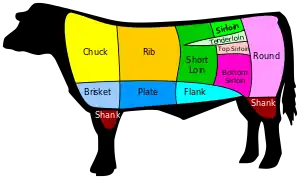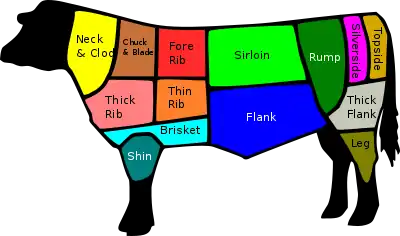Rib steak
A rib steak is a beef steak sliced from the rib primal of a beef animal, with rib bone attached. In the United States, the term rib eye steak is used for a rib steak with the bone removed; however, in some areas, and outside the U.S., the terms are often used interchangeably. The "rib eye" or "ribeye" was originally, the central portion of the rib steak, without the bone, resembling an eye.
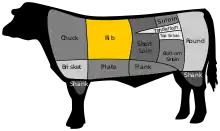 | |
It is considered a more flavorful cut than other steaks, such as the fillet, due to the muscle being exercised by the animal during its life. It's the marbling of fat that makes this suitable for slow roasting or grilling cooked to different degrees of doneness. Marbling also increases tenderness, which plays a key role in consumers' rib steak purchase choices. [1][2]
- The short ribs: several ribs cut from the rib and plate primals and a small corner of the square-cut chuck.
Terminology
- In the United States cuisine, a bone-attached beef rib can be called "rib steak", "beef rib", "bone-in beef rib", "tomahawk steak", "bone-in rib steak", "ribeye steak" or "cowboy cut".
- In Australia and New Zealand, a bone-in rib steak is called a "ribeye". When the bone is removed, Australians and New Zealanders call the resulting piece of meat a "Scotch fillet" or "whiskey fillet".
- In French cuisine, the rib steak (with bone attached, called côte de bœuf, literally: "beef rib") is a very popular dish and it is not uncommon to find French restaurants where a massive single côte de bœuf is served for two or more dinner guests. The French entrecôte corresponds to the rib eye steak, that is, a rib steak separated from its bone.
- In Argentine cuisine, roast short ribs are called indistinctly asado de tira or tira de asado. The rib steak is known as ancho de bife for the entire cut, served with or without the bone, and ojo de bife for the rib eye.
- In Spanish cuisine, in Spain, a bone-attached rib steak is called chuletón, while the same cut of meat, when its bone is removed, is called, in Spain, entrecote, a word originated in the French entrecôte.
- In British cuisine, the terms cote de boeuf, and tomahawk steak, have been widely adopted to refer to the bone-attached rib steak.
- In the Middle East, Beef Ribs are often found in Rib Restaurants instead of the non Halal Pork Ribs.
Images
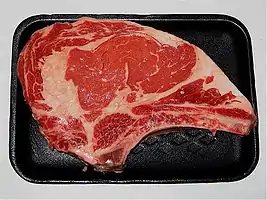 A rib steak, raw, with bone attached
A rib steak, raw, with bone attached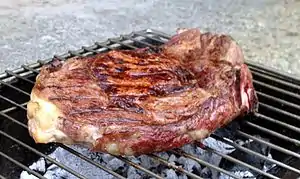 A rib steak, grilled on a barbecue
A rib steak, grilled on a barbecue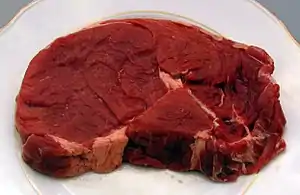 A raw French rib eye steak,
A raw French rib eye steak,
without the bone (entrecôte) A rib steak, grilled in a griddle
A rib steak, grilled in a griddle
and served with French fries
References
- Lusk, Jayson L.; Fox, John A. (August 2001). "Regional Differences in Consumer Demand for Beef Rib-Eye Steak Attributes" (PDF). Mississippi State University Division of Agriculture, Forestry, and Veterinary Medicine.
- Reiman, Miranda (January 12, 2012). "Achieving the two important qualities in beef: marbling and tenderness". www.farmanddairy.com.
